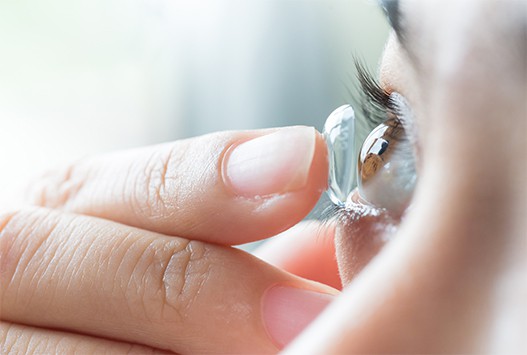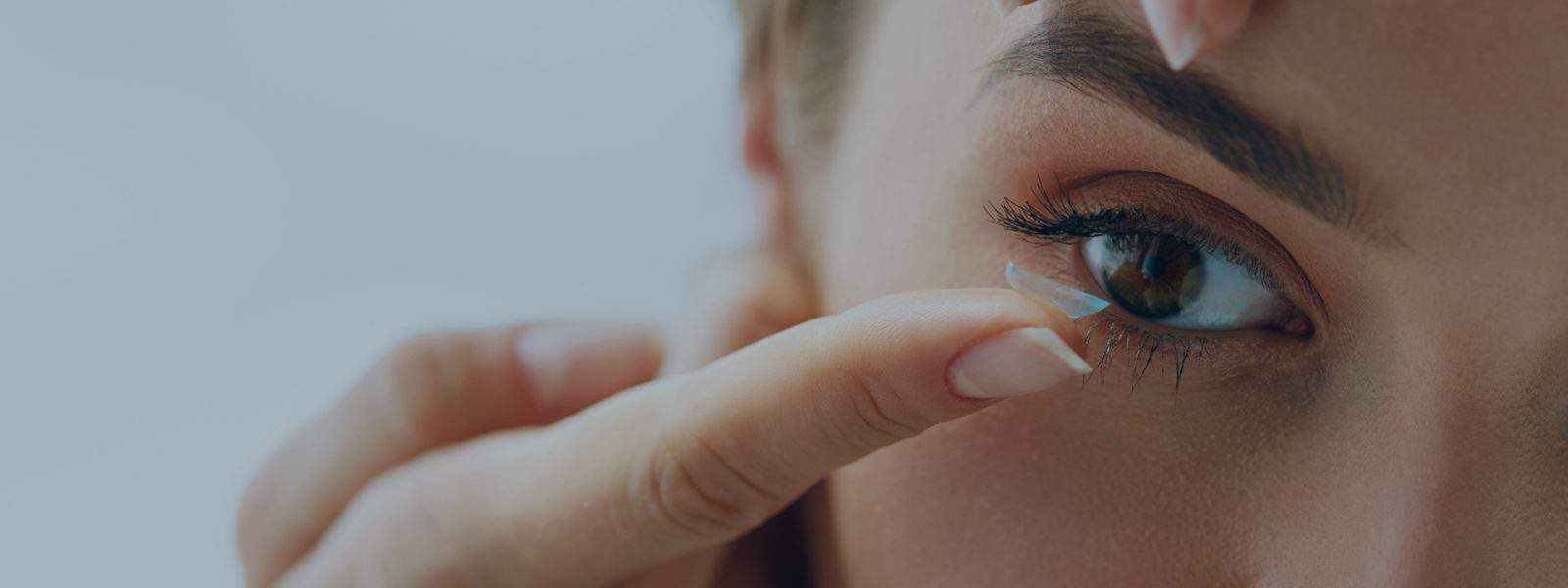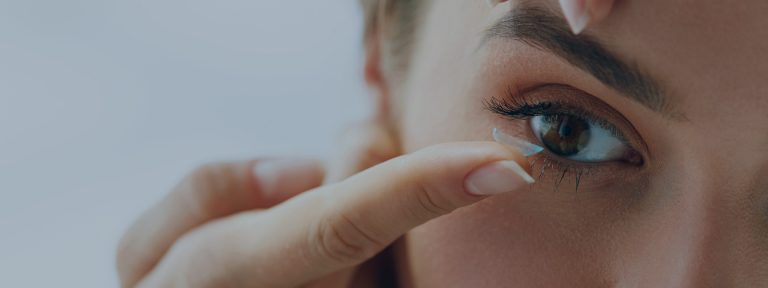Contact Lenses

Contact lenses can correct refractive errors, such as astigmatism, and presbyopia (age-related need for extra reading correction) myopia (near-sightedness), and hyperopia (far-sightedness). Contact lenses are an alternative to wearing glasses and allows for a full field of vision that provides comfort for everyday activities.
Soft contact lenses are the most popular choice, due to the comfort and ease of care. Disposable contact lenses are also popular because frequent replacement insures good comfort and vision and reduces the risk of infection. Soft contact lens wear is safer now than ever before. Contact lens manufacturers are using new technology that enhances oxygen permeability. This is important because the more oxygen that goes to surface of the eye, the less contact lens wear complications.
Rigid gas permeable contact lenses (RGPs), made of a harder, oxygen permeable material, are another contact lens option. RGPs is sometimes a better option for patients who have corneal shape irregularities or who have significant astigmatism.
For patients with presbyopia, there are a number of options available for contact lens wear. For those who are trying to reduce the need for eyeglasses, bifocal contact lenses are available in both RGP and soft materials. Monovision (blended vision), fitting is another technique that is used to minimize reliance upon glasses. The Monovision technique corrects one eye for distance vision and the other eye is corrected for reading vision. Monovision may work better than bifocal contact lenses for some patients.
Soft Contacts
Soft contact lenses are made from a flexible water-absorbing plastic polymer that allows oxygen to pass through to nourish your eyes as you wear the lenses.
Handling Techniques for Soft Contact Lenses
- Wash your hands thoroughly, rinse well, and dry with a lint free towel.
- Inspect the lens to make sure it is not inverted. If the lens is right side out it will make a nice bowl appearance. If the lens is inverted (wrong side out) the edges will flare out slightly.
- Use the middle finger of the same hand to pull down on the lower lashes and lid.
- Use your forefinger or middle finger of your other hand to hold the lashes of the upper lid against your brow and then place the lens directly on the center of your eye gently but securely. Do not blink until the lens has been inserted and your fingers have been removed from your eyelids.
- Always verify the proper position of the lens by checking your vision immediately after insertion.
- Use the same technique or reverse your hands when inserting the other lens.
Eye Drops
One or two drops of lens lubricant are recommended if your lenses feel dry or if blurry vision occurs while wearing. Eye drops may also be helpful prior to removal if your lenses feel dry.
Removal
Wash your hands before removal. Slide the edge of your lens down onto the white part of your eye (sclera). Then gently squeeze the lens between your thumb and forefinger to remove.
Cleaning of Soft Contact Lenses
It is essential that you always practice good hygiene when handling your lenses. Always wash your hands thoroughly with a mild soap and rinse to remove all remaining soap residue then dry your hands with a lint-free towel. Once the lens has been removed, follow the instructions provided with your specific lens care system. Place the lens in your storage case containing a fresh supply of solution and soak them for at least four hours before they are worn again.
Contact lens cases can be a source of bacterial growth. Lens cases should be emptied, cleaned, rinsed, and allowed to air dry after each use. Lens cases should be replaced at regular intervals.
Wearing Schedule
New contact lens wearers should build-up wear time slowly. You should start with approximately four hours of wear time and add two hours each day until you are up to a full day of wear time (12 to 14 hours). Do not continue to wear your lenses if your eyes are excessively uncomfortable or red. Periodic progress visits are required to help ensure your safety, comfort, and visual function.
Rigid gas permeable contact lenses (RGP’s)
Care and Wearing Instructions
Rigid gas permeable contact lenses (RGP’s) are made from a special plastic material that combines the superior visual correction of older conventional hard contact lenses with similar comfort qualities of soft contact lenses. This material allows a high level of oxygen to pass through the lens and nourish the cornea resulting in a healthy fit with excellent vision.
Handling Techniques for RGP’s
Insertion
- Wash your hands thoroughly.
- Always start with the right lens to avoid confusion. (Most RGP’s will have a small dot near the edge of the right lens).
- Rinse lens with wetting and conditioning solution and place the lens on the tip of your index finger and use the middle finger of the same hand to pull down on the lower lashes and lid.
- Use your forefinger or middle finger of your other hand to hold the lashes of the upper lid against your brow and place the lens directly on the center of your eye gently but securely. Do not blink until the lens has been inserted and your fingers have been removed from your eyelids.
- Always verify the proper position of the lens by checking your vision immediately after insertion.
- Use the same technique or reverse your hands when inserting the other lens.
Removal
There are 2 methods you can use to remove this lens:
Blink Method
Place your index finger at the outer junction of your upper and lower lids, pull outward and slightly upward while keeping your eyes wide open. Cup your other hand below your eye and blink briskly. The lens will be pinched by the pressure of your eyelids and will pop into your hand.
Two-Finger Method
Place the tip of the forefinger of one hand on the central upper lid margin (nearest your lashes) while also placing the forefinger of your other hand on the central lower lid margin. Press the upper and lower lid margins gently against your eye and then slide them together wedging the lens out of the eye.
Centering a Rigid Gas Permeable Contact Lens
A lens may become displaced onto the white portion of the eye while learning to remove lenses or occasionally while they are being worn. If this occurs look up and down while pulling the lids away to easily locate the lens. If you cannot locate the lens with a mirror, it may be far under the upper eyelid or it may have fallen out of the eye. Do not panic, it is physically impossible for the lens to become lost behind the eye. Look in the opposite direction of where the lens is located and push the lens onto the cornea by utilizing one of the following techniques:
- Close your eyelids gently and massage the lens into place with light finger pressure through the eyelids. Check your vision to be sure it is centered.
- While looking in the extreme opposite direction of the location of the lens, trap the lens by exerting finger pressure behind the lens. Maintain this pressure and then look in the direction of the displaced lens. This should result in the centering of the lens on the cornea. Check your vision to be sure it is centered.
Care of Rigid Gas Permeable Contact Lenses
Once the lens has been removed, place the right lens and several drops of cleaner in the palm of your hand and rub the lens gently in the cleaner for 10 seconds so that both surfaces are cleaned. Rinse the cleaner from the lens and from your fingers with sterile saline. Place the lens in a storage case containing a fresh supply of soaking or conditioning solution for at least four hours before they are worn again. Contact lens cases can be a source of bacterial growth. Lens cases should be emptied, cleaned, rinsed, and allowed to air dry after each use.
Wearing Schedule
You should start with approximately two hours of wear time and add two hours each day until you are up to a full day of wear time (12 to 14 hours).





